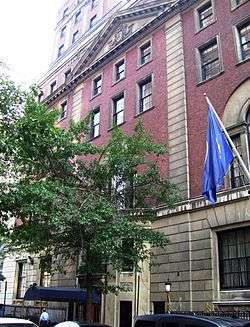Union League

The Union Leagues were a group of men's clubs established during the American Civil War to promote loyalty to the Union, the Republican Party, and the policies of Abraham Lincoln. They were also known as Loyal Leagues. They were composed of upper middle class members who provided financial support for organizations such as the United States Sanitary Commission, which provided medical supplies to treat wounded soldiers after battle. The clubs supported the Republican Party with funding, organizational support, and political activism.
The Union League of Philadelphia, established in 1862, was the first to be formed, and still exists, as do the Union League Clubs of New York and Chicago. Membership in the league is selective, and is comparable in social status to membership in a country club. Union League buildings often serve as private social clubs.
South
During Reconstruction, Union Leagues were formed across the South after 1867 as all-black working auxiliaries of the Republican Party. They were secret organizations that mobilized freedmen to register to vote and to vote Republican. They discussed political issues, promoted civic projects, and mobilized workers opposed to certain employers. Most branches were segregated but there were a few that were racially integrated. The leaders of the all-black units were mostly urban blacks from the North, who had never been slaves. Eric Foner reports:
- By the end of 1867 it seemed that virtually every black voter in the South had enrolled in the Union League, the Loyal League, or some equivalent local political organization. Meetings were generally held in a black church or school.[1]
The activities of the Union League in the defeated South during the early Reconstruction years did not meet with much favor among local whites. They feared the Union League was dominated by Radical Republicans intent on mobilizing the black vote and disenfranchising white Democrats, in particular former Confederate soldiers whom they characterized as traitors.[2]
Postwar
After the Civil War, members of the Union League Club of New York helped to found the Metropolitan Museum of Art,[3] and to build the Statue of Liberty's pedestal[4] and Grant's Tomb. The building of the former Union League Club of Brooklyn now serves as a senior citizens' home,[5] while the home of the former Union League Club of New Haven is used as a restaurant.[6]
The Union League Civic and Arts Foundation[7] was established in 1949 as a public, not-for-profit charitable and educational organization. The Foundation's mission is one of community enrichment; it is funded largely by contributions from members of the Union League Club of Chicago.
Famous historical members of the League include Cyrus McCormick, Robert Todd Lincoln, Daniel Burnham, William D. Boyce,[8] and Charles D. Barney.[9]
See also
- Union League of Philadelphia
- Union League Club of Chicago
- Union League Club of New York
- Union League Golf and Country Club
- List of American gentlemen's clubs
References
Notes
- ↑ Eric Foner, "Black Reconstruction Leaders at the Grass Roots" in Leon F. Litwack and August Meier, eds. (1991). Black Leaders of the Nineteenth Century. p. 221.
- ↑ Steven Hahn, Steven. A nation under our feet: Black political struggles in the rural South, from slavery to the great migration (2003). pp 165-205
- ↑ John K. Howat, "Founding friends - of the Metropolitan Museum of Art, New York, New York", The Magazine Antiques, January 2000 issue.
- ↑ National Park Service Statue of Liberty website Archived August 31, 2006, at the Wayback Machine..
- ↑ "Landmark Architecture of Crown Heights North", Gothamist, July 20, 2006.
- ↑ Union League Cafe website Archived February 1, 2011, at the Wayback Machine.
- ↑ Union League Civic and Arts Foundation
- ↑ Petterchak 2003, p. 11
- ↑ Union League of Philadelphia. The League, 1909
Bibliography
- Fitzgerald, Michael W. (1989) The Union League Movement in the Deep South: Politics and Agricultural Change During Reconstruction
- Fleming, Walter L. (1905) Civil War and Reconstruction in Alabama Macmillan. pp 553–59
- the most detailed study, full text online at the Gutenberg Project at link above
- Foner, Eric (1988) Reconstruction: America's Unfinished Revolution, 1863-1877 pp.283–86
- Lawson, Melinda (2002) "The Civil War Union Leagues and the Construction of a New National Patriotism" Civil War History Volume: 48. Issue: 4. pp.338+.
- Lawson, Melinda (2002) Patriot Fires: Forging a New American Nationalism in the Civil War North
- Silvestro, Clement M. (1966) Rally Round the Flag: The Union Leagues in the Civil War
- Tremel, Andrew T. (Winter 2013) “The Union League, Black Leaders, and the Recruitment of Philadelphia’s African American Civil War Regiments,” Pennsylvania History, 80, pp.13–36.
- Primary sources
- Fleming, Walter L. (ed.) (1906) Documentary History of Reconstruction: Political, Military, Social, Religious, Educational, and Industrial vol 2 pp 1–29.
- Loyal National League of the State of New York (1863) The Great Questions of the Times: The Great Mass Meeting of the League and Other Loyalists at Union Square, New York
- complete text online at link above
External links
| Wikisource has the text of a 1911 Encyclopædia Britannica article about Union League. |